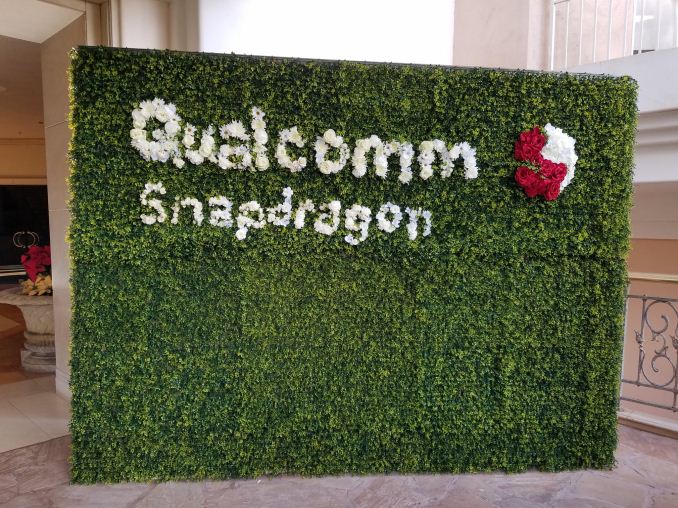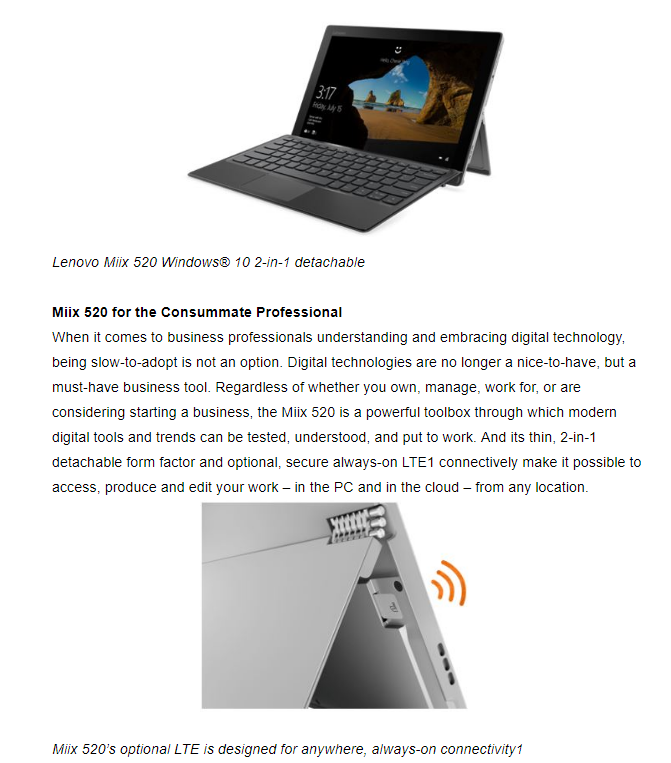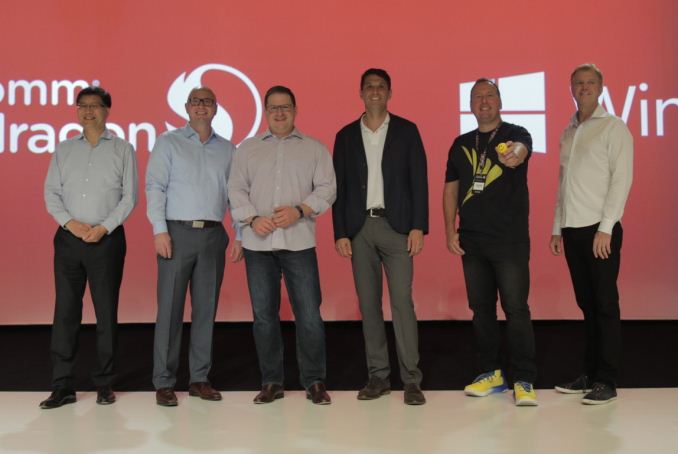Shots Fired as Qualcomm Bets on Always Connected Devices with Long Battery Life: Intel Responds
by Ian Cutress on December 5, 2017 5:00 PM EST
At the Qualcomm Snapdragon Technology Summit today, the majority of the keynote was aimed squarely at how a new product segment of ‘Always Connected PCs’ with all-day battery life will bridge the gap between the utility of a smartphone and the productivity of a PC. The critical take home message from Qualcomm, and the partners that showed devices at the event, was that by using a smartphone chip on a smaller PCB and an integrated modem, laptop designs could be stuffed with a battery and as long as it has the right OS and software combination, it will offer a better user experience than what is available currently. Qualcomm has extensively worked with Microsoft on creating a version of Windows 10 that works on their Snapdragon 835 SoCs, and is now ready to declare deployment.
Joining Qualcomm on the stage for the announcement were the key partners (from left to right):
- Jerry Shen, ASUS CEO: Announcing the ASUS NovaGo
- Kevin Lensing, CVP and GM of Client at AMD: Announcing Ryzen Mobile partnership
- Cristiano Amon, EVP Qualcomm Technologies
- Terry Myerson, EVP of Microsoft Windows and Devices: Announcing Windows 10 on ARM
- Gunther Ottendorfer, COO of Sprint: Reinforcing Connectivity Partnership
- Kevin Front, VP and GP of Consumer Systems HP: Announcing HP Envy x2
Cristiano Amon, executive vice president of Qualcomm Technologies and president of QCT, was joined on stage by senior executives from Microsoft, Asus, Sprint, HP and AMD announcing the new class of Always Connected PC, at Qualcomm’s second annual Technology Summit Tuesday, Dec. 5, 2017 in Maui, HI. Photo Source: Qualcomm Technologies, Inc.
Now creating a new product category that is successful is difficult. How many attempts at a tablet were there before the market warmed to them, for example. Or consider how many smart watches have come and gone since the inception. As bright as all the semblance of new technology is, the major incumbent in the notebook PC space also had something today.
Intel Responds
In a nutshell, Intel’s response was:
[Intel] has been powering always-connected PCs since their inception. Today, there are more than 30 business- and consumer-oriented Intel-based always-connected PCs available, offering the leading performance, a variety of connectivity options and price points, long battery life and thin and light form factor design.
The response is basically a ‘we’ve had always-connected PCs for years’. This is true: while normally focused on the business use case, laptops with LTE connectivity do exist from most of the major OEMs. This usually comes in the form of an add-in card and a business contract situation, although I personally have owned a number of laptops that do offer SIM card slots for this sort of functionality.
Intel is citing designs such as the HP ProBook 400 Series, Samsung’s Galaxy Book 12, the Lenovo ThinkPad L470, the Lenovo Miix 520, the Google Pixelbook, and the Mi Notebook Air, with more designs coming in 2018. Intel is also citing that it has modems in future devices capable of Gigabit LTE as well, along with its investments into 5G. Intel also cites that it has full compatibility with Windows and 64-bit software.

From Lenovo's Miix 520 website
So is what Qualcomm is doing new? Will it succeed? Truth be told, they are reinvigorating interest in this type of device, regardless of if it has already been around, and pushing it for other use cases. Intel has often pushed its devices for new use cases over the years, but this time it is a new silicon manufacturer playing the game in a slightly different way. The devices that come out, be it with a Qualcomm SoC or an Intel CPU with extra modem, are both going to have positives and drawbacks – Qualcomm is touting all-day battery life and instant screen-on without sleeping, while Intel goes for performance and compatibility.
Shots fired? The annual CES event in Las Vegas is happening in early January. I expect Qualcomm, Intel, and all the OEMs to be screaming about ‘Always Connected PCs’. It’s a fun time to be a consumer.
Related Reading
- Qualcomm Snapdragon Tech Summit: Day One Live Blog
- ASUS Announces the NovaGo (TP370): A Snapdragon 835 based Windows 10 PC
- Microsoft Launches Windows 10 On ARM: Always Connected PCs
- The Qualcomm Snapdragon 835 Performance Preview
- Microsoft and Qualcomm Collaborate to Bring Windows 10 & x86 Emulation to Snapdragon Processors











45 Comments
View All Comments
inighthawki - Wednesday, December 6, 2017 - link
Windows RT failed because it was a completely locked down platform with literally zero developer support, so the only thing you could do with it was basic web browsing and notepad. These devices have full x86 support (albeit with degraded performance depending on the scenario) and the ability to unlock the device to run apps/programs not just from the store. I feel like they've solved the two huge hurdles they originally faced.abufrejoval - Tuesday, December 5, 2017 - link
There is nothing wrong with computing devices (including servers) which are always ready to interact with the network or any other potential interface, especially when they don't use any significant amount of energy for being ready.There is everything wrong with computing devices always connected to Microsoft or any other vendor or manufacturer with a dependency that is a mix of slavery and blackmail, where you are owned rather than obtaining or retaining ownership over what you purchased.
A purchase is not an indenture and this practice needs to be stopped and punished severely.
Microsoft is luring customers into swapping a personal computer for a Larry Niven droud with attractive technology: Don't let yourself be trapped, but fight for a disconnected Microsoft, Google, Facebook and...
well I guess there is no sense APPLEaling to wireheads
Hurr Durr - Wednesday, December 6, 2017 - link
"Disconnected goog", ahahaha.duploxxx - Wednesday, December 6, 2017 - link
The issue is dear Intel that when yours truly got the monopoly by financially screwing competitors you also implemented a way of working dominating and stating how your products aught to be sold and designed. This created a different market, as you wanted to push the business always your way. Now you have again competition in many directions (finally) and you notice that the business is changing and no longer controllable or possible to redirect the way you want. SO you get scared, bold and pushed in a corner. Currently you just solve it by pushing more funding money into system builders pockets asking for more products from yourself.... that is again screwing the business as usual.yeeeeman - Wednesday, December 6, 2017 - link
This time Intel is right, Qualcomm didn't bring something new with their always connected PCs.I also like how all big players in the industry say that they listen to customer needs and they do what they are requested. Who do you listen really, because I bet almost no one needs internet on their PCs in the woods or in the desert, where, lets be fair, not even LTE reaches or in any case, the speed will be very slow for web browsing.
Matter of the fact is that the industry doesn't listen to customer needs, they just create needs for the customers and try to convince us that we need it. That is what drives sales and revenues and that is what they do. A big smelly s**t put in a nice wrap, to make it desirable.
FunBunny2 - Wednesday, December 6, 2017 - link
"I also like how all big players in the industry say that they listen to customer needs"Jobs created stuff, and sometimes got it right, that folks didn't know they needed. IBM did that with the 360 and Burroughs with the B machines; both decades ago. IOW, the really smart folks are ahead of the sheep, the drudges do the backfill afterwards. arguably, Jobs did some of that, too.
MrSpadge - Wednesday, December 6, 2017 - link
The comment summary appears to be: "I don't like it because it doesn't fit how I use my current PC & smartphone without the capabilities of these new machines"iwod - Wednesday, December 6, 2017 - link
The problem is price. Intel dont have anything at that Qualcomm Price range, and that does even include the cost of Modem which Qualcomm has it built in.Gunbuster - Wednesday, December 6, 2017 - link
The real comedy gold will be if Microsoft never uses ARM in their own device and uses all this to get a price cut from intel on the next Surface device CPU.HStewart - Wednesday, December 6, 2017 - link
Microsoft did this before with Window RT. ARM will never main stream Laptops that used Intel CPU and it be naïve to think Intel is not watching this for up and coming 10nm laptops - like to have at least 22 hour battery life - and one actually wonders why Intel's 10nm - which about the same as Samsung unreleased 7nm process is being delay. Because Intel is not stupid and planning for the future.